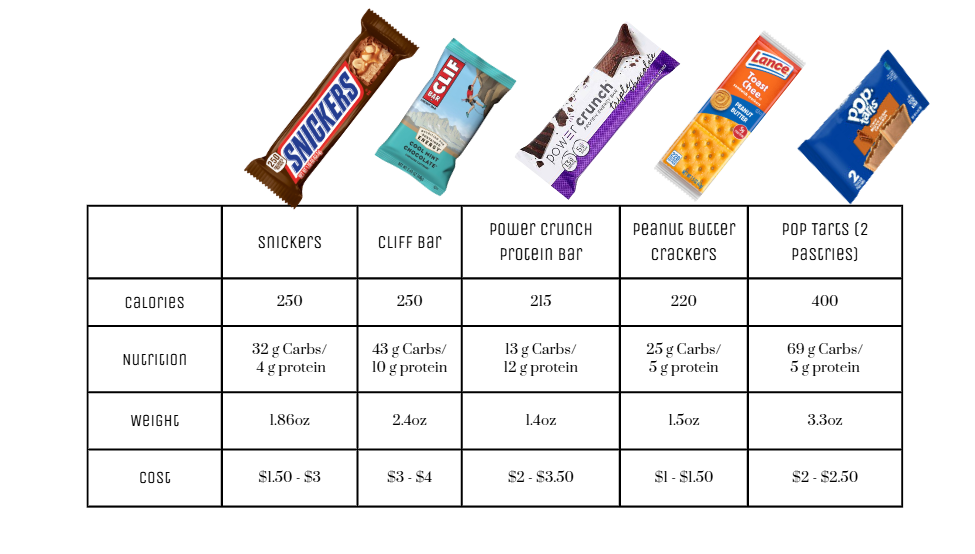Food Crash-Course: Picking the Right Fuel for You
One of the most common questions about trail life is, “But, what do you eat?” We have spent just as much time choosing our food as we have dialing in our gear. There is a give-and-take to selecting food that fuels you while also being backpacker friendly.
We walk through the trade-offs of popular hiker food items and how you can develop your own priorities to find the right snacks for you!
It is true that thru hiking takes an elevated caloric intake from regular life; however, calories are not the only thing that matters when purchasing food and snacks for the backcountry. It is a balancing act between 5 factors:
Calories
Weight
Nutrition
Enjoyment
Cost
We will explore each of these categories, but ultimately you will have to decide which factors are most important to you.
#1 Calories
Keeping the metaphor of food is fuel for your body, calories are the way to determine how much fuel you are giving yourself. Too few calories a day and not only will you be hungry, but you will also feel tired, recover slower, and feel the impact of hiking more. Everyone is different when it comes to caloric needs, but a general recommendation would be between 2,200-4,500 calories a day. This will fluctuate based on the number of miles and altitude. Yes, that’s right at higher altitudes you need more calories.
Calorically dense foods will reduce the amount of food of need to bring in a resupply. Example, a 100 calorie Fiber One bar vs 240 Snickers bar. You will want to focus on food that is calorie dense in order to assure you are fueling and aiding in recovery.
#2 Weight
Food will likely make-up a good portion of your pack weight. Your food bag can quickly weigh >15 pounds if you are not watching closely.
Weight and Calories often go hand-in-hand. To get more bang for your buck, consider both the weight of the food and the amount of fuel it provides. Caloric density is measured by dividing the calories/ounces. A good rule of thumb is to aim for food that has 100 calories per 1 ounce or caloric density >=100.
For example: Snickers bar weighs 1.86 ounces and provides 220 calories. To make this a ‘lightweight’ hiking food that is calorie dense, it would have to provide at least 186 calories.
#3 Overall nutrition
Fueling your body correctly under intensive exercise, such as thru hiking, is crucial. You will want to have food that is nourishing to power you through 10+ mile days. Thru-hiking food is known to be stereotypical ‘junk food’. Snicker bars and Pop tarts are hiking staples and you are likely to see these at most resupplies. However, you do need more than just than just calories. An item can be calorically higher but have low nutritional value. If calories are the fuel then nutrition is the type of fuel.
Overall, the better quality your food the better you will feel! Incorporate foods with fiber, protein, and healthy fats to keep you full and fit.
One of the switches we made between the two trails was our breakfast. We swapped the Hostess donuts for granola and powdered milk. Both items have the same caloric density, but the granola kept us fuller throughout the morning and ultimately allowed us to buy fewer morning snacks.
#4 Enjoyment
If you are like us, then you find comfort in food. This is why neither of us cold-soak because we look forward to a hot meal at the end of the day, especially if it’s mac & cheese! Pick food that is going to make a hard day of hiking enjoyable. Maybe that is a bag of sour gummy worms, or a Doritos, just something to spark that “Boy I cannot wait to eat XYZ!”
It is difficult in limited resupply to find your preferred foods, but generally when you are able, do not force yourself to eat something in the back country that you wouldn’t ever eat in normal life. If you hate bacon then do not select the fully loaded flavor option of instant mashed potatoes even though it is more calorically dense than another flavor. At the end of the day food is no good to you if you are not going to eat it.
#5 Cost
Similar to finding gear, cost is an overarching factor. Eating healthy is often more expensive, and thru-hiking food is no exception. There is no denying that a Snicker bar cost less than a protein bar. A cheaper resupply will consist of candy bars and instant potatoes or ramen, while a pricier one can include protein bars, granola, and mac & cheese. You will have to consider the calories, weight, nutrition, and enjoyment of the food to your personal budget.
Now being able to perfectly balance these factors is uncommon in a true resupply scenario because the local gas station will likely have limited supply choices. Be prepared for the trade-offs in cost to be different at a Walmart (when there is a $0.50 differential) to a mountain general store (with a $1.50 differential). Ultimately the goal you are working toward is knowing when to prioritize calories, weight, nutrition, enjoyment with cost.
Popular Hiking Snacks
Let’s put these theoretical into action. Below are some common backpacking snacks to see the comparison:
Each of these snacks has a similar caloric density - an example of a snack that would have a terrible caloric density would be an apple.
Next let’s move on to evaluating the nutrition. You can see that nutrition and cost have a relationship. The higher the snack is in protein the more the snack costs. If you are maintaining weight on trail (meaning you don’t need to consume high calories) then you might find that a $3.00 Power Crunch bar will do the same as 2 Snickers that cost $4.00 total. If you are losing weight and constantly feeling hungry then a combination of Pop Tarts and a Power Crunch bar would work to keep you fuller longer while also driving up calories, but cheaper than buying 3 protein bars.





How many different ways can you make potatoes on trail? There are dozens of potato flavors, but even these can become exhausting to eat. Adding ramen to make a famous ‘ramen bomb’ (what it sounds like, mixing ramen and potatoes together) is not the exact seasoning I need to make them more palatable. That being said, we can’t deny that potatoes are a light and inexpensive resupply option.